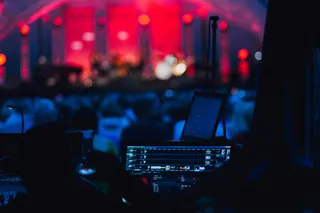Theater is an art form that relies heavily on sound. From the booming narration that sets the stage to the gentle whispers that build dramatic tension, every aspect of a theatrical production hinges on the clarity and effectiveness of the audio. Whether it’s a small local play or a grand Broadway-style production, the right audio equipment is essential to bring the story to life. In this blog post, we will explore the five must-have audio equipment pieces that every theatrical production needs to create an immersive and unforgettable experience.
1. Wireless Microphones: The Backbone of Clarity
Wireless microphones are a critical piece of equipment for theatrical productions, especially in performances involving numerous actors moving freely across the stage. These devices allow performers to be heard clearly without being tethered to a cable, offering full range of movement that is essential for dynamic blocking and choreography.
The two primary types of wireless microphones used in theaters are lavalier (clip-on) and headset microphones. Lavalier mics are often favored for their subtlety—they are small and can be hidden in the actor’s costumes, ensuring that the audience focuses on the performance and not on the equipment. Headset microphones, on the other hand, are more stable and offer better sound quality, ideal for productions where clear vocals are a must.
Pro Tip: Make sure to use high-quality wireless microphone systems that minimize interference and have strong battery life to avoid mid-performance disruptions.
2. Mixing Console: The Brain of the Operation
The mixing console is the control center of your audio setup, and it plays an essential role in ensuring a balanced and polished sound for the audience. The mixer allows the sound technician to control every input, from microphones to backing tracks, adjusting volume levels, equalization (EQ), and effects in real time.
For a theatrical production, a digital mixing console is typically preferred because of its versatility and the ability to save presets. This means that once you’ve adjusted the settings for each scene, you can easily recall them with a push of a button, making transitions smoother and reducing the chance of errors.
Pro Tip: Ensure your mixing console has enough channels to accommodate all your inputs. The more actors and effects you have, the more channels you will need.
3. Stage Monitors: Keeping the Cast in Sync
Stage monitors are a must-have to help actors, singers, and musicians hear themselves clearly during a performance. Without proper monitoring, it’s difficult for performers to stay in tune, deliver lines with the correct timing, or stay in sync with the background music or sound effects. Stage monitors can be traditional wedge speakers positioned at the edge of the stage or in-ear monitors that give the actors a personal audio feed.
For a theatrical production, having a clear monitoring setup is particularly important in musical scenes, where actors need to hear the accompaniment clearly to keep their pitch and tempo in line. Effective stage monitoring helps prevent missed cues and keeps every aspect of the performance running smoothly.
Pro Tip: In-ear monitors offer a more discreet and customizable solution, allowing each performer to control their own mix for maximum comfort and clarity.
4. PA System: Reaching Every Corner of the Venue
A PA (Public Address) system is essential for ensuring that every member of the audience, from the front row to the back, can hear the performance. The PA system generally consists of speakers, amplifiers, and subwoofers that are placed strategically around the venue to distribute sound evenly.
Choosing the right PA system depends on the size and acoustics of your theater. For smaller venues, a basic two-speaker setup may suffice, while larger theaters may require multiple speakers, subwoofers, and delay speakers to account for longer distances and varied acoustics. A well-calibrated PA system ensures that the dialogue, music, and sound effects are heard clearly by every audience member without any distortion.
Pro Tip: Consider conducting a sound check in an empty venue and again with an audience to ensure that the PA system is properly adjusted to the unique acoustics of both situations.
5. Audio Interface and Playback Device: Seamless Sound Effects and Music
In theatrical productions, sound effects and background music play a vital role in setting the mood, building tension, and enhancing the storytelling experience. An audio interface and playback device allow you to seamlessly integrate pre-recorded sound effects and music into the live performance.
Using a high-quality audio interface ensures that these sound files are transmitted without latency, maintaining a perfect synchronization with the onstage action. Whether you’re adding the sounds of thunder to a dramatic storm scene or subtle background music to build emotional intensity, an audio playback system allows the sound operator to queue up and trigger each effect with precise timing.
Pro Tip: Software-based playback devices like QLab or Ableton Live are popular choices in theaters, as they offer flexibility, reliable control, and integration with other digital components.
Conclusion: Crafting an Unforgettable Theatrical Experience
Audio is the invisible yet powerful force that shapes a theatrical production, ensuring that every whisper, song, and dramatic moment reaches the audience exactly as intended. By incorporating these five must-have audio equipment pieces—wireless microphones, a mixing console, stage monitors, a PA system, and an audio interface with playback device—you can create an immersive, professional-quality sound environment for your production.
The next time you’re planning a theatrical performance, consider how these pieces of audio equipment will help you craft a show that resonates emotionally and audibly with your audience. With the right gear in place, your performers will be able to focus on their craft, and your audience will leave with an experience that echoes in their memories long after the curtain falls.

